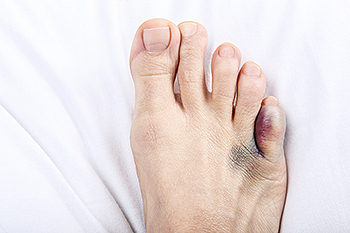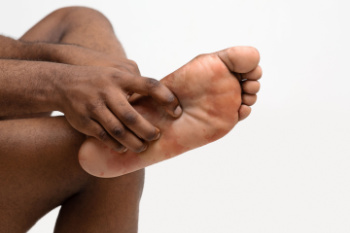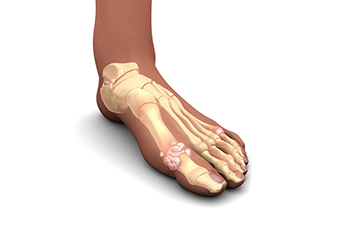Items filtered by date: February 2024
Pickleball Can Hurt Your Feet

Pickleball has surged in popularity in recent years, particularly among seniors. With over 3 million players in the United States alone, its appeal lies in its competitive nature and minimal running requirements. Played on a smaller court with elements of badminton, table tennis, and tennis, it offers both exercise and competition. However, it is still physically demanding, akin to tennis and racquetball, involving rapid movements and sudden changes in direction. As the sport grows, it is important to consider appropriate footwear and injury prevention. To learn more about how to play pickleball safely, it is suggested that you schedule an appointment with a chiropodist who can evaluate your feet, guide you toward proper footwear choice, and educate you on the importance of proper preparation for this enjoyable sport.
Injuries to the foot and ankle are very common among athletes. If you have experienced an injury, please consult with Chiropodist Stephanie Poupore from North Bay Foot & Ankle. Our clinician will assess your condition and provide you with quality foot and ankle treatment.
Common Injuries Among Athletes:
Achilles tendon injuries
Ankle strains or sprains
Plantar fasciitis
Fractures
Turf toe
Joint dislocations
Sever’s disease
Morton’s neuroma
Symptoms
Symptoms will depend on the cause and severity of the injury. Common symptoms for a foot or ankle injury include pain, swelling, tenderness, bruising, a reduced range of motion, and difficulty bearing weight or walking on the affected foot or ankle.
Diagnosis
Sports injuries are typically diagnosed after carefully examining the affected foot or ankle. This includes moving the injured area to test its range of motion. Medical history will need to be provided, as well as detailed information about how the injury occurred. Imaging studies, such as X-rays or MRIs, may be used to confirm or rule out certain diagnoses.
Treatment
Just like symptoms, treatment will depend on the type of injury and its severity. Initial treatment for many sports injuries is aimed at controlling inflammation and promoting the healing response. The acronym R.I.C.E is a helpful guide to implement for most acute injuries. This method involves resting, icing, compressing, and elevating the affected foot or ankle. In addition, anti-inflammatory medications may be administered and orthotic devices may be prescribed. For more severe injuries, surgery may be required. Lastly, rehabilitation or physical therapy may be needed to gain full functionality in the afflicted area.
If you have any questions, please feel free to contact our office located in . We offer the newest diagnostic and treatment technologies for all your foot care needs.
Indicators of a Broken Toe

A broken toe, a painful predicament that can disrupt the simplest of activities, arises from a myriad of causes, demanding a discerning eye for both symptoms and origins. Trauma, whether from a stubbed toe, heavy object impact, or an unfortunate misstep, stands as a common instigator of toe fractures. Sporting activities, where the toes are vulnerable to sudden and forceful movements, can also contribute to the risk. Identifying a broken toe relies on astute recognition of telltale signs, including intense pain, swelling, bruising, and difficulty in bearing weight on the affected toe. Deformity or misalignment may be visible, emphasizing the urgency of seeking medical attention. If you have endured a broken toe, it is strongly suggested that you visit a chiropodist who can offer the treatment that is best for you.
A broken toe typically occurs following either a sudden, traumatic injury, like dropping a heavy piece of furniture on the toe. The impact causes the bone to fracture and produces a variety of painful symptoms. If you suspect that you’ve broken your toe, please consult with Chiropodist Stephanie Poupore from North Bay Foot & Ankle. Our clinician can help you maintain the health of your lower limbs and your mobility.
Symptoms
Throbbing pain
Swelling
Bruising
Cracking sound at the time of injury
Difficulty bearing weight on the toe
Difficulty walking
Toe resting at an unnatural angle
Diagnosis
Your chiropodist can diagnose a broken toe through physical examination and imaging studies, such as X-rays.
Treatment
The main goals of treatment are to ensure that the bone heals properly, as a toe fracture that doesn’t heal properly can lead to osteoarthritis. You will typically need to rest the affected toe. You may be prescribed a splint to immobilize the toe while it heals. Icing the affected toe and taking over-the-counter medications can help reduce pain. In cases of severe fractures, surgery may be necessary to reset the broken bones and make sure that they heal correctly.
If you have any questions, please feel free to contact our office located in . We offer the newest diagnostic and treatment technologies for all your foot care needs.
Symptoms and Diagnosis of Plantar Fasciitis

Plantar fasciitis is a common foot condition affecting millions of people across the globe, primarily active adults aged 25 to 65. It stems from the overuse or stretching of the plantar fascia, a tissue supporting the foot's arch, leading to inflammation and pain. Symptoms may develop gradually or suddenly, typically including heel pain, morning discomfort, tenderness, stiffness, and arch pain. Common causes can include repetitive stress, weight gain, tight calf muscles, inadequate footwear, and abrupt activity changes. Diagnosis involves a physical examination and sometimes imaging tests. Nonsurgical treatment options are effective for over 90 percent of patients and include rest, cold therapy, stretching, night splints, supportive shoes, and more. Surgical intervention is rare, and saved for non-responsive cases. Choosing the right shoes is vital, focusing on arch support, cushioning, heel support, and shock absorption. If you have persistent heel or arch pain, it is suggested that you schedule an appointment with a chiropodist for appropriate pain relief and prevention techniques.
Plantar fasciitis can be painful and interfere with your daily activities. If you are experiencing foot or heel pain and believe you may be afflicted with plantar fasciitis, please consult with Chiropodist Stephanie Poupore from North Bay Foot & Ankle. Our clinician will assess your condition and provide you with quality foot and ankle treatment.
What Is Plantar Fasciitis?
Plantar fasciitis refers to the inflammation of the plantar fascia, a ligament that runs along the bottom of the foot and connects the heel bone to the toes. Repetitive activities, such as running or jumping, can injure the plantar fascia over time. Plantar fasciitis can also be caused by flat feet, high arches, pregnancy, and activities that put excessive pressure on your feet, like standing all day for work. When the plantar fascia becomes inflamed, it causes pain and discomfort.
Symptoms
Typical symptoms of plantar fasciitis include:
Stabbing pain near the heel
Pain that is worst in the morning or after a period of rest
Pain that increases after exercising
Swelling
Tightness in the Achilles tendon
Diagnosis
Plantar fasciitis is typically diagnosed via medical history and physical examination.
Treatment
Treatments for plantar fasciitis include resting and icing the affected foot, stretching the foot, taking medications to reduce inflammation, and wearing orthotics. In severe cases where pain does not improve with conservative treatments, injections or surgery may be recommended.
If you have any questions, please feel free to contact our office located in . We offer the newest diagnostic and treatment technologies for all your foot care needs.
Reminder: When Was the Last Time...?
The Diagnostic Process for Gout

Gout, a form of inflammatory arthritis, requires a meticulous diagnostic approach to pinpoint its presence and pave the way for effective management. The diagnosis typically begins with a detailed medical history and examination, where the chiropodist assesses symptoms such as sudden and intense joint pain, swelling, and redness. Laboratory tests play a vital role, with a blood test measuring elevated levels of uric acid, which is a key indicator of gout. In some cases, a synovial fluid analysis may be conducted by extracting fluid from the affected joint to check for urate crystals. Imaging studies such as X-rays or ultrasound may be employed to examine joint damage and monitor the progression of the disease. The comprehensive diagnostic process allows chiropodists to differentiate gout from other conditions with similar symptoms and tailor an appropriate treatment plan. If you have developed gout, it is strongly suggested that you are under the care of a chiropodist who can accurately diagnose and help you to manage this condition.
Gout is a painful form of arthritis that can affect anyone. Please consult with Chiropodist Stephanie Poupore from North Bay Foot & Ankle. Our clinician will assess your condition and provide you with quality foot and ankle treatment.
What Is Gout?
Gout is characterized by sudden, severe attacks of pain, redness, and tenderness in the joints. This type of arthritis is caused by a buildup of uric acid in the bloodstream. When uric acid crystallizes in a joint, often the joint of the big toe, it can bring about a gout attack.
Symptoms
Symptoms of gout include:
Sudden and severe pain
Swelling
Redness
Warmth
Joint stiffness
Joint deformity
Diagnosis
A chiropodist will ask questions about your personal and family medical history, followed by an examination of the affected joint. Laboratory tests and x-rays are sometimes ordered to determine if the inflammation is caused by something other than gout. A sample of fluid taken from your joint can show whether it contains uric acid.
Treatment
Prescription medications or injections are used to treat the pain, swelling, and inflammation. Patients with chronic gout can also use behavioral modifications such as diet, exercise, and decreased intake of alcohol to help minimize the frequency of gout attacks. Foods and beverages that are high in purines should be avoided since purines are converted in the body to uric acid. If left untreated, this painful condition can leave your joint permanently damaged and swollen.
If you have any questions, please feel free to contact our office located in . We offer the newest diagnostic and treatment technologies for all your foot care needs.

